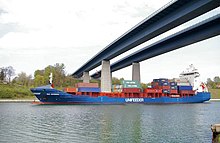Canal helmsman

With Kanalsteurer or short Steurer referred to specially trained former captains and nautical officers on ships during the passage of the Kiel Canal (NOK), the rudder use. These qualified helmsmen should ensure safe passage through the canal. Ships with a canal helmsman on the Kiel Canal cannot do without a pilot , however; he takes on an advisory role for the ship's captain. The skipper remains the captain. Canal pilots and helmsmen complement each other with their special knowledge of the area and their tasks, thus ensuring a safe canal passage as a team.
Task
The canal helmsman takes over from the helmsman of the regular crew. It helps to increase the capacity of the NOK, because it can handle the encounter of ships sailing at the same time that would otherwise have to wait in turnouts . Unlike the only advisory pilot, he also assumes liability for incorrect steering.
Due to the relatively large width of the ship and the relatively small width of the canal bed, special effects occur during the passage through the canal, which depend on the width of both ships involved, the shape of their underwater hull and their speed. The canal helmsman, unlike a helmsman in the regular crew, must be able to assess the dynamic properties of the ship in the canal with all the edge effects during encounters and when sailing near the bank, even when the rudder angle changes.
The ship initially causes a surge , which also affects oncoming comers in the course, and then a suction that acts both on the bank and on oncoming people when passing. When navigating through the area, for example in docks or rivers, such edge effects do not play a role because of the low speed or large distance. In the Kiel Canal, the canal helmsman must assess the transition from the surge at the beginning of the encounter to the suction during the encounter in such a way that a collision does not occur. That takes a lot of experience.
Acceptance of the canal helmsman
Not every ship has to request a canal helmsman for the passage. Smaller ships such as sailing yachts may use the Kiel Canal as self-propelled. Canal helmsmen need to be requested from a certain ship size. The tables show ship dimensions for which it is mandatory to have a canal helmsman on board.
Between Kiel-Holtenau and Rüsterbergen :
| length | 100.0 m / 115.0 m |
|---|---|
| width | 15.5 m / 14.0 m |
| Draft | 6.1 m / 6.1 m |
With a length of 100 m, a ship can have a width of 15.5 m without the need for a rudder. A 115 m long ship would have to be correspondingly narrower - max. 14 m - without having to call a helmsman.
Between Rüsterbergen and Brunsbüttel :
| length | 100.0 m / 120.0 m |
|---|---|
| width | 16.5 m / 14.5 m |
| Draft | 6.1 m / 6.1 m |
If a ship exceeds the following values, it must accept two canal helmsmen, a so-called gang:
| length | 100.0 m / 120.0 m |
|---|---|
| width | 19.0 m / 17.0 m |
| Draft | 7.0 m / 7.0 m |
fees
The fees for the canal helmsman are set out in the “Ordinance on the fees for helmsmen on the Kiel Canal (Canal Taxes Ordinance)”.
history
After the Kiel Canal (NOK), then called Kaiser Wilhelm Canal , was opened on June 22, 1895 , it became clear that the canal was difficult to navigate. Almost every twentieth ship was damaged . The ships often ran into the embankment and got stuck.
The problem was to be solved according to the Dutch and Belgian model by specially trained canal helmsmen who take over the rudder (steering wheel) of the ship for the duration of the passage. In October 1899, with the permission of the State Secretary for the Interior, the canal helmsman's service was set up. The first eight fully trained canal helmsmen were ready in 1900.
Due to the specialization of the canal helmsmen and their accumulated experience, the passage through the Kiel Canal became much safer and the number of accidents decreased.
This profession is unique in Germany, Steurer has no other inland waterway. Although canal helmsmen are often confused with pilots, they represent a separate professional group. The canal helmsmen have an extended nautical license as nautical experts .
Verein der Kanalsteurer e. V.
The association has been taking care of all the concerns and interests of the canal helmsmen since it was founded on September 24, 1908. It is an association of employees and takes on the protection of the professional interests of the canal helmsman, administers the collected canal helmsman fees, hires new tax candidates and takes on other tasks. A board of directors takes on the administration of the association. The canal helmsmen elect their board every two years. The chairman of the board represents the association externally. The manager of the board of directors is active. The headquarters of the Verein der Kanalsteurer e. V. is located on the lock island in Kiel-Holtenau .
Individual evidence
- ↑ Ordinance on the fees for canal helmsmen on the Kiel Canal. (PDF) Directorate-General for Waterways and Shipping, January 1, 2017, accessed on September 21, 2019 .

